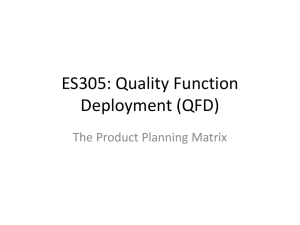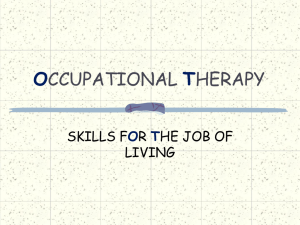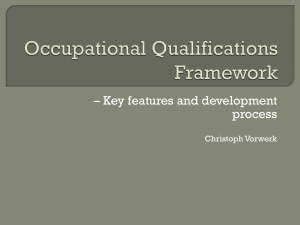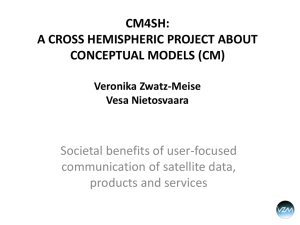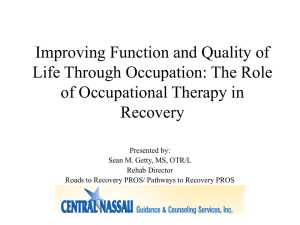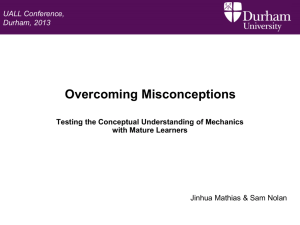What is Conceptual Framework?
advertisement
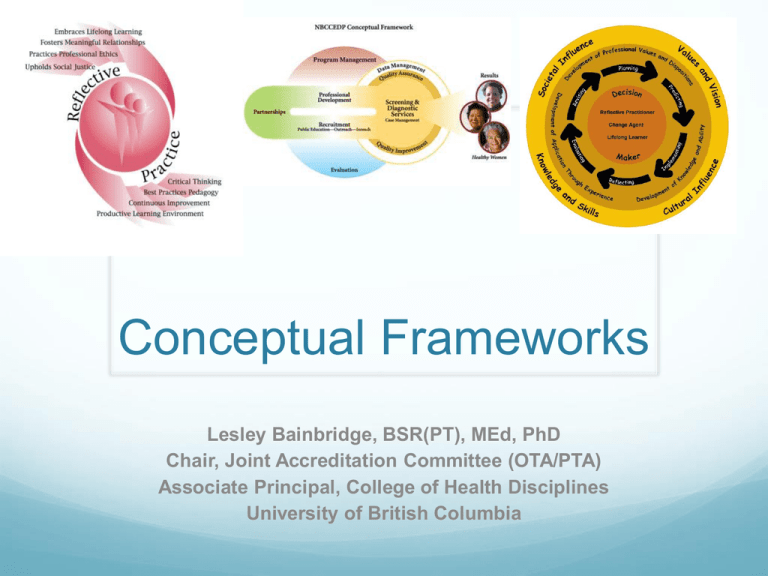
Conceptual Frameworks Lesley Bainbridge, BSR(PT), MEd, PhD Chair, Joint Accreditation Committee (OTA/PTA) Associate Principal, College of Health Disciplines University of British Columbia What is a conceptual framework? A theoretical structure of assumptions, principles, and rules that holds together the ideas comprising a broad concept. A group of concepts that are broadly defined and systematically organized to provide a focus, a rationale, and a tool for the integration and interpretation of information. Conceptual frameworks …. provide a foundation and organization for the educational plan in schools…. Addresses the why and the how of a curriculum. They can be simple….. ….or complex Think-Pair-Share Think about your curriculum – How is it organized? What concepts do you focus on? What theories do you use to inform your curriculum design, implementation and evaluation? Share key thoughts with a colleague sitting near you. Share collective thoughts with the large group. Steps to using conceptual frameworks to… Describe values, philosophy, goals as they apply to the curriculum; Organize educational components of the curriculum such as content and learning objectives; Explain process components of curriculum such as teaching and assessment approaches; Apply theory to each component of a curriculum to help to explain choices. Components Context Learning objectives Conceptual framework Professional and educational overview Goal statement philosophy Key processes Pre-requisites Course content Instructional design Assessment approaches STEP 1: Explaining the context AN EXAMPLE: CONTEXT UNDERPINNING THE CURRICULUM CONCEPTUAL FRAMEWORK The OTA/PTA educational program at Smith College offers a curriculum that not only helps fulfill the mission of the Department, Faculty and College, but is designed to attract excellent students and, in partnership with the occupational therapy, physical therapy and health professional communities, to support them to achieve their career aspirations. The OTA/PTA program, offering a diploma designation, benefits from and is influenced by the environment in which it is located. This includes: A College in which participation and involvement teaching excellence is expected and rewarded; An Administration that sets high standards for admission, curriculum, and graduation; A range of health professional programs that collectively commit to improving health care for the province through innovation and accountability; A Canadian OTA/PTA context recognized for its practice process, evidence-based competencies and client-centred guidelines. Step 2: Describing the conceptual framework components and purpose EXAMPLES: CONCEPTUAL FRAMEWORK FOR OTA/PTA PRACTICE AND EDUCATION (1) The curriculum is based on a conceptual framework that advances the mission of the OTA/PTA program and consists of a goal statement, learning objectives, professional and educational philosophy, and four key processes (learning, practice, movement, and participation in occupation). In turn, the conceptual framework guides decisions about pre-requisites, course content, instructional methods, and assessment of student learning. (2) Smith College’s OTA/PTA Educational Conceptual Framework consists of a definition, a philosophy and values statement, a description of they key learning theories that provide the foundation to the curriculum, and examples of how this framework guides the curriculum as a whole, as well as decision making regarding prerequisites, course content, instructional methods, and the evaluation /assessment of student learning. STEP 3: Practice philosophy/framework Occupational Therapy Practice Occupational therapy is a client-centred profession that contributes to individual and population health. Occupational therapists domain of concern is the interaction among person, environment, and occupation. Meaning is idiosyncratic and multidimensional. Occupational therapists support performance, participation, and engagement in occupations chosen by clients as necessary and meaningful to their life roles, transitions, and circumstances. Occupational therapy theory and practice is based on a holistic perspective of mind, body, and spirit that recognizes the unique needs of individuals and communities Occupational therapy theory and practice must be based on, developed and verified through research. STEP 3: Learning philosophy/framework Occupational Therapy Learning Learning environments that cultivate open communication, personal growth, critical thinking, advocacy, and respect and tolerance for others are essential to prepare occupational therapists for practice. Acknowledging that everyone’s a learner and everyone’s a teacher supports the habits of life-long learning essential to meet the challenges of the health care system and a changing society. These habits include scientific inquiry, creativity, problem-solving, adaptability, and curiosity. Our intellectual and social lives are enriched by value-centred learning. We therefore encourage debate, respect difference, and embrace discovery, foster intercultural understanding, and promote interdisciplinary collaboration. Diverse, experiential approaches to higher learning and professional education, appropriately supported by technology, support learner preferences and maximize resources to achieve learning goals. Teaching is a scholarly practice involving reflection, research, and evaluation. STEP 3: VALUES AND GOALS Values: In order to deliver a curriculum of the highest quality, we believe in: Learning that is lifelong, interactive and transformative Excellence in teaching and learning High standards for professionalism Goal(s): Our primary goal is/goals are: To engage and transform students in learning To educate competent, practice-ready OTA/PTA graduates Step 4: Educational theories and models Transformative learning theory (Mezirow) Social constructivism (Merriam and Caffarella) Critical pedagogy (Shor) Theory of experiential learning (Kolb) Cognitive neuroscience theory (Mergel) Bloom’s taxonomy of learning (Bloom) Step 5: Practice theories and models Movement Continuum (Cott et al) International Classification of Function (ICF) (WHO) Occupational Performance Model (Law et al) Step 5: Application of theory and models An educator using social constructivism in the classroom or the practice setting will: Recognize prior learning and experiences Require students to consider the social determinants of health Specific examples of social constructivism in our curriculum include: Case-based discussions facilitating self-understanding Fieldwork experiences where learning is constructed within specific contexts Assessments derived from social constructivism: Use group assignments designed to share creative-problemsolving Prompt students to identify assumptions Step 6: draw your framework Pull up google images and type in “conceptual frameworks” – see how people conceptualize in figures, diagrams, drawings and text. Try to draw a rough model to build on. Reference: UBC Occupational Therapy Step 7: Pull the framework together using text and conceptual graphics Outline: Context for your conceptual framework Elements of your conceptual framework: Philosophy Values Educational theories and applied model Practice theories and applied model Assessment theories and applied model Graphic representation How you use your conceptual model to inform your curriculum/educational program Summary Conceptual frameworks: Answer the why and how questions related to your curriculum Organize the curriculum into elements that can be explained, justified and tested Guide curriculum decisions and renewal for both classroom and practice contexts Evolve as curricula change based on internal and external forces Thank you to… My Occupational Therapy colleagues at: The University of British Columbia The University of Toronto The University of Manitoba Thank you….

